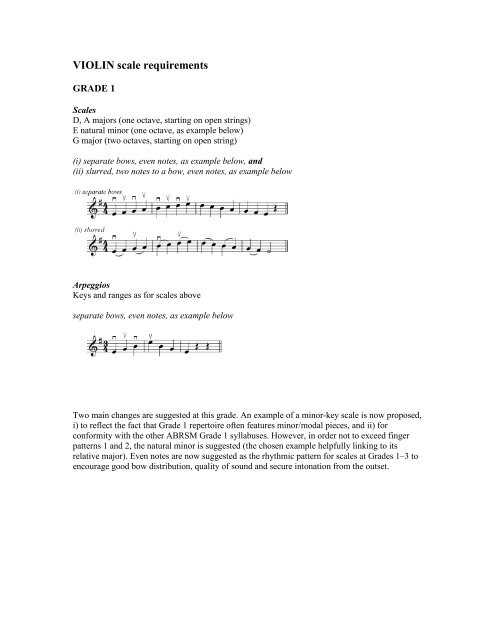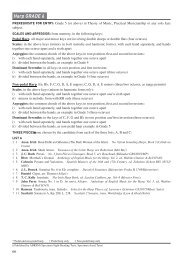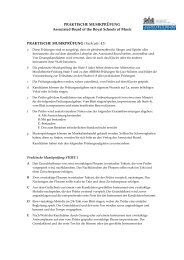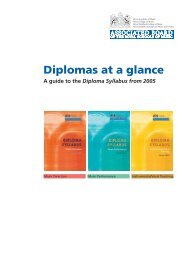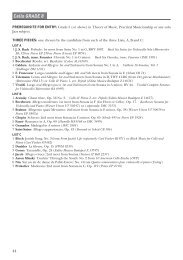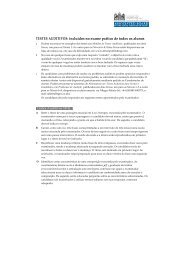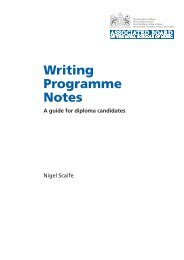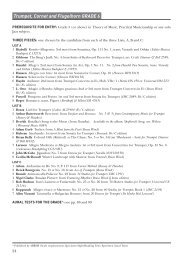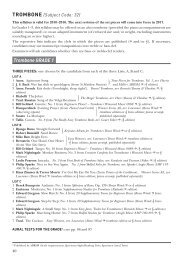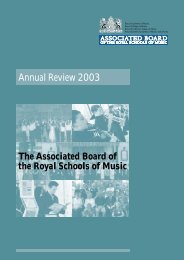VIOLIN scale requirements - ABRSM
VIOLIN scale requirements - ABRSM
VIOLIN scale requirements - ABRSM
You also want an ePaper? Increase the reach of your titles
YUMPU automatically turns print PDFs into web optimized ePapers that Google loves.
<strong>VIOLIN</strong> <strong>scale</strong> <strong>requirements</strong><br />
GRADE 1<br />
Scales<br />
D, A majors (one octave, starting on open strings)<br />
E natural minor (one octave, as example below)<br />
G major (two octaves, starting on open string)<br />
(i) separate bows, even notes, as example below, and<br />
(ii) slurred, two notes to a bow, even notes, as example below<br />
Arpeggios<br />
Keys and ranges as for <strong>scale</strong>s above<br />
separate bows, even notes, as example below<br />
Two main changes are suggested at this grade. An example of a minor-key <strong>scale</strong> is now proposed,<br />
i) to reflect the fact that Grade 1 repertoire often features minor/modal pieces, and ii) for<br />
conformity with the other <strong>ABRSM</strong> Grade 1 syllabuses. However, in order not to exceed finger<br />
patterns 1 and 2, the natural minor is suggested (the chosen example helpfully linking to its<br />
relative major). Even notes are now suggested as the rhythmic pattern for <strong>scale</strong>s at Grades 1–3 to<br />
encourage good bow distribution, quality of sound and secure intonation from the outset.
<strong>VIOLIN</strong> <strong>scale</strong> <strong>requirements</strong><br />
GRADE 2<br />
Scales (minors melodic or harmonic, at candidate’s choice)<br />
C, F majors (one octave)<br />
G, D minors (one octave, starting on open strings)<br />
G, A, Bb majors (two octaves)<br />
(i) separate bows, even notes, as example below, and<br />
(ii) slurred, two notes to a bow, even notes, as example below<br />
Arpeggios<br />
Keys and ranges as for <strong>scale</strong>s above<br />
separate bows, even notes, as example below<br />
Only two changes are proposed – the even-note pattern for <strong>scale</strong>s (as in Grade 1) and the removal<br />
of one minor-key <strong>scale</strong> and arpeggio (A minor). This deletion results in a smoother progression in<br />
the number of <strong>requirements</strong> across the first three grades, while also ensuring that Violin matches<br />
the Viola, Cello and Double Bass <strong>requirements</strong>, where only two minor keys are featured at this<br />
grade.
<strong>VIOLIN</strong> <strong>scale</strong> <strong>requirements</strong><br />
GRADE 3<br />
Scales (minors melodic or harmonic, at candidate’s choice)<br />
Ab, Eb, E majors (one octave)<br />
Bb, D majors (two octaves)<br />
A, D minors (two octaves)<br />
(i) separate bows, even notes, as example below, and<br />
(ii) slurred, two notes to a bow, even notes, as example below<br />
Arpeggios<br />
Keys and ranges as for <strong>scale</strong>s above<br />
(i) separate bows, even notes, as example below, and<br />
(ii) slurred, three notes to a bow, even notes, as example below<br />
Chromatic <strong>scale</strong>s<br />
Starting on open string D (one octave)<br />
separate bows, even notes, as example below<br />
An appreciable reduction in the workload is proposed at this grade. Dominant sevenths are now<br />
postponed until Grade 4, as it is felt more appropriate to introduce only one new form (the<br />
chromatic <strong>scale</strong>) at Grade 3. Moreover, just one chromatic <strong>scale</strong> (starting on open string D) is<br />
now proposed, since the current requirement of three examples (all starting on open strings) is<br />
considered unnecessary duplication. In a similar case of addressing duplicated <strong>requirements</strong>, the<br />
G and A major <strong>scale</strong>s and arpeggios (two octaves) are no longer proposed, as they have already<br />
been featured in the preceding grades. Two new keys are introduced instead, among the oneoctave<br />
<strong>scale</strong>s and arpeggios – Eb and Ab – furthering the exploration of flat keys in first position.
<strong>VIOLIN</strong> <strong>scale</strong> <strong>requirements</strong><br />
GRADE 4<br />
Scales (minors melodic or harmonic, at candidate’s choice)<br />
Ab, B, C, Eb majors (two octaves)<br />
G, B, C minors (two octaves)<br />
(i) separate bows, even notes, as example below, and<br />
(ii) slurred, two beats to a bow, as example below<br />
Arpeggios<br />
Keys and ranges as for <strong>scale</strong>s above<br />
(i) separate bows, even notes, as example below, and<br />
(ii) slurred, three notes to a bow, even notes, as example below<br />
Dominant sevenths (resolving on the tonic, as example below)<br />
In the key of C (starting on open string G) (one octave)<br />
In the key of D (starting with first finger on A) (one octave)<br />
separate bows, even notes, as example below<br />
(cont.)
Violin <strong>scale</strong> <strong>requirements</strong> Grade 4 (cont.)<br />
Chromatic <strong>scale</strong>s<br />
Starting with first finger on A and E respectively (one octave)<br />
(i) separate bows, even notes, as example below, and<br />
(ii) slurred, four notes to a bow, even notes, as example below<br />
With only seven <strong>scale</strong> and arpeggio keys now featured (as opposed to the current nine), a more<br />
realistic workload is again proposed. There is also one less example each of chromatic <strong>scale</strong>s and<br />
dominant sevenths, to reduce duplication. Of the two dominant sevenths, one starts on an open<br />
string and the other with first finger, and slurred bowing for this form is now postponed until the<br />
next grade. Two rhythmic patterns are now proposed for the conventional <strong>scale</strong>s from this grade<br />
onwards: i) separately bowed, using even notes (as in the proposed new Grades 1–3); and ii)<br />
slurred, using the long-tonic pattern familiar from the current syllabus.
<strong>VIOLIN</strong> <strong>scale</strong> <strong>requirements</strong><br />
GRADE 5<br />
Scales (minors melodic or harmonic, at candidate’s choice)<br />
Db, Eb, E majors (two octaves)<br />
B, C#, E minors (two octaves)<br />
G, A majors (three octaves)<br />
G, A minors (three octaves)<br />
(i) separate bows, even notes, as example below, and<br />
(ii) slurred, two beats to a bow, as example in below<br />
Arpeggios<br />
Keys and ranges as for <strong>scale</strong>s above<br />
(i) separate bows, even notes, as example below, and<br />
(ii) slurred, three notes to a bow, even notes, as example below<br />
Dominant sevenths (resolving on the tonic, as examples below)<br />
In the key of Bb (starting on F) (one octave)<br />
In the keys of C and D (starting on G and A respectively) (two octaves)<br />
(i) separate bows, even notes, as example below, and<br />
(ii) slurred, four notes to a bow, even notes, as example below<br />
(cont.)
Violin <strong>scale</strong> <strong>requirements</strong> Grade 5 (cont.)<br />
Diminished sevenths<br />
Starting on open strings G and D (one octave)<br />
separate bows, even notes, as example below<br />
Chromatic <strong>scale</strong>s<br />
Starting on G, A and Bb (two octaves)<br />
(i) separate bows, even notes, as example below, and<br />
(ii) slurred, four notes to a bow, even notes, as example below<br />
Three-octave A major/minor is added to the syllabus (alongside the existing G major/minor over<br />
three octaves), in order to instil greater confidence in playing in the higher reaches of the<br />
instrument. In compensation, three fewer examples of two-octave <strong>scale</strong>s and arpeggios are<br />
proposed. There is one less example of diminished sevenths than in the current syllabus, with<br />
slurred bowing for this form now postponed until the next grade. Slurred bowing for arpeggios<br />
and chromatic <strong>scale</strong>s is simplified, with just one pattern for each.
<strong>VIOLIN</strong> <strong>scale</strong> <strong>requirements</strong><br />
GRADE 6<br />
Scales (minors both melodic and harmonic)<br />
C, Eb, F# majors (two octaves)<br />
C, Eb, F# minors (two octaves)<br />
G, Bb majors (three octaves)<br />
G, Bb minors (three octaves)<br />
(i) separate bows, even notes, as examples below, and<br />
(ii) slurred, seven notes to a bow, as example below<br />
Arpeggios<br />
Keys and ranges as for <strong>scale</strong>s above<br />
(i) separate bows, even notes, as example below, and<br />
(ii) slurred, even notes:<br />
- six notes to a bow (over two octaves), as example below<br />
- three notes to a bow (over three octaves), as example below<br />
(cont.)
Violin <strong>scale</strong> <strong>requirements</strong> Grade 6 (cont.)<br />
Dominant sevenths (resolving on the tonic, as examples below)<br />
In the keys of C, Eb, F, Ab and B (starting on G, Bb, C, Eb and F# respectively) (two octaves)<br />
(i) separate bows, even notes, as example below, and<br />
(ii) slurred, four notes to a bow, even notes, as example below<br />
Diminished sevenths<br />
Starting on G, Bb, C, Eb and F# (two octaves)<br />
(i) separate bows, even notes, as example below, and<br />
(ii) slurred, four notes to a bow, even notes, as example below<br />
Chromatic <strong>scale</strong>s<br />
Starting on G, Bb, C, Eb and F# (two octaves)<br />
(i) separate bows, even notes, as example below, and<br />
(ii) slurred, six notes to a bow, even notes, as example below<br />
Double-stop <strong>scale</strong> (broken)<br />
In sixths in Bb major (one octave)<br />
rhythm and bowing in broken steps, as example below<br />
(cont.)
Violin <strong>scale</strong> <strong>requirements</strong> Grade 6 (cont.)<br />
As in Grade 5, only one bowing pattern is now set for slurred chromatic <strong>scale</strong>s, resulting in a<br />
more logical progression across the grades. Otherwise, from Grade 6, the use of tonal centres<br />
becomes universally applied, so that the starting notes for chromatic <strong>scale</strong>s, dominant and<br />
diminished sevenths now match those for the <strong>scale</strong>s and arpeggios in each grade, creating a<br />
pedagogically holistic approach. (NB the examiner will ask for the various elements individually<br />
and not by tonal centres.) Across Grades 6–8 all major and minor keys are encountered (over two<br />
or three octaves).
<strong>VIOLIN</strong> <strong>scale</strong> <strong>requirements</strong><br />
GRADE 7<br />
Scales (minors both melodic and harmonic)<br />
F, F# majors (two octaves)<br />
F, F# minors (two octaves)<br />
A, B, D majors (three octaves)<br />
A, B, D minors (three octaves)<br />
(i) separate bows, even notes, as examples below, and<br />
(ii) slurred, seven notes to a bow, as example below<br />
Arpeggios<br />
Keys and ranges as for <strong>scale</strong>s above<br />
(i) separate bows, even notes, as example below, and<br />
(ii) slurred, even notes:<br />
- six notes to a bow (over two octaves), as example below<br />
- three notes to a bow (over three octaves), as example below<br />
(cont.)
Violin <strong>scale</strong> <strong>requirements</strong> Grade 7 (cont.)<br />
Dominant sevenths (resolving on the tonic, as examples below)<br />
In the keys of G, Bb and B (starting on D, F and F# respectively) (two octaves)<br />
In the keys of D and E (starting on A and B respectively) (three octaves)<br />
(i) separate bows, even notes, as example below, and<br />
(ii) slurred, four notes to a bow, even notes, as example below<br />
Diminished sevenths<br />
Starting on D, F and F# (two octaves)<br />
Starting on A and B (three octaves)<br />
(i) separate bows, even notes, as example below, and<br />
(ii) slurred, four notes to a bow, even notes, as example below<br />
Chromatic <strong>scale</strong>s<br />
Starting on D, F and F# (two octaves)<br />
Starting on A and B (three octaves)<br />
(i) separate bows, even notes, as example below, and<br />
(ii) slurred, twelve notes to a bow, even notes, as example below<br />
(cont.)
Violin <strong>scale</strong> <strong>requirements</strong> Grade 7 (cont.)<br />
Double-stop <strong>scale</strong>s (broken)<br />
In sixths in G and Bb majors (one octave)<br />
In octaves in D major (one octave)<br />
rhythm and bowing in broken steps, as examples below<br />
One additional tonal centre is proposed at this grade, in order to create a more progressive<br />
pathway in terms of workload across the final three grades. However, the current syllabus’s<br />
requirement for <strong>scale</strong>s and arpeggios all to be played over three octaves is relaxed, with four<br />
examples now over two octaves. The slurred bowing patterns for arpeggios, dominant and<br />
diminished sevenths are simplified. The double-stop <strong>scale</strong>s in sixths are now to be played in<br />
broken steps (as in Grade 6), with the ‘together’ form postponed until Grade 8.
<strong>VIOLIN</strong> <strong>scale</strong> <strong>requirements</strong><br />
GRADE 8<br />
Scales (minors both melodic and harmonic)<br />
Ab, Bb, C, Db, Eb, E majors (three octaves)<br />
G#, Bb, C, C#, Eb, E minors (three octaves)<br />
(i) separate bows, even notes, as example below, and<br />
(ii) slurred, seven notes to a bow, as example below<br />
Arpeggios<br />
Keys and ranges as for <strong>scale</strong>s above<br />
(i) separate bows, even notes, as example below, and<br />
(ii) slurred, nine notes to a bow, even notes, as example below<br />
Dominant sevenths (resolving on the tonic, as examples below)<br />
In the keys of Db, Eb, F, F#, Ab and A (starting on Ab, Bb, C, C#, Eb and E respectively) (three<br />
octaves)<br />
(i) separate bows, even notes, as example below, and<br />
(ii) slurred, four notes to a bow, even notes, as example below<br />
(cont.)
Violin <strong>scale</strong> <strong>requirements</strong> Grade 8 (cont.)<br />
Diminished sevenths<br />
Starting on C, C#, Eb and E (two octaves)<br />
Starting on Ab and Bb (three octaves)<br />
(i) separate bows, even notes, as example below, and<br />
(ii) slurred, four notes to a bow, even notes, as example below<br />
Chromatic <strong>scale</strong>s<br />
Starting on C, Db, Eb and E (two octaves)<br />
Starting on Ab and Bb (three octaves)<br />
(i) separate bows, even notes, as example below, and<br />
(ii) slurred, twelve notes to a bow, even notes, as example below<br />
Double-stop <strong>scale</strong>s (together)<br />
In sixths in Eb major (two octaves)<br />
In octaves in D major and G minor (both melodic and harmonic) (one octave)<br />
separate bows, even notes, as examples below<br />
Double-stop <strong>scale</strong> (broken)<br />
In thirds in Bb major (two octaves)<br />
rhythm and bowing in broken steps, as example below<br />
(cont.)
Violin <strong>scale</strong> <strong>requirements</strong> Grade 8 (cont.)<br />
A substantial reduction in the workload is proposed at this grade. The current requirement to<br />
prepare all keys (12 tonal centres) for <strong>scale</strong>s and arpeggios is now proposed to be reduced by<br />
50%, i.e. to six tonal centres only. The slurred bowing for conventional <strong>scale</strong>s is also significantly<br />
rationalized, with all examples now required only seven notes to a bow, thus allowing candidates<br />
to perform with greater confidence (the current syllabus’s two/three octaves to a bow is<br />
considered excessively demanding). There are also simplifications in the slurring patterns for<br />
arpeggios, dominant and diminished sevenths. One less chromatic <strong>scale</strong> is now required, although<br />
the number of dominant and diminished sevenths is expanded, to cover the full set of keys of the<br />
tonal centres examined at this grade.<br />
Even notes are now proposed as the rhythmic pattern for the double-stop <strong>scale</strong>s in sixths and<br />
octaves, thereby matching the separately bowed <strong>requirements</strong> at all grades. The double-stop <strong>scale</strong><br />
in thirds is now to be played in broken steps (as with sixths and octaves when first introduced in<br />
Grades 6 and 7, respectively).<br />
In compensation for these simplifications, most <strong>requirements</strong> at this grade are now to be prepared<br />
over three octaves, while the tessitura is extended up by two semitones to the tonal centres of Eb<br />
and E, to reflect the fact that the repertoire at this level frequently reaches this area of the<br />
instrument.


